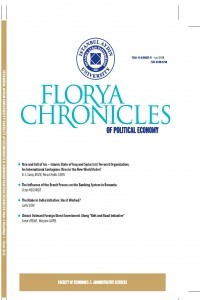Determinants of Consumer Satisfaction of Mobile Commerce in Turkey
Determinants of Consumer Satisfaction of Mobile Commerce in Turkey
M-Commerce E-Commerce, Structural Equation Model,
___
- [1] Alfahl, H., Sanzogni, L., Houghton, L., Sandhu, K. (2012). Mobile Commerce Adoption in Organizations: A Literature Review and Preliminary Findings. 10(2): 47-68. doi:10.4018/978-1-4666-4510-3.ch003 [2] Anh, C.P. (2015). Factors Influence Customer Satisfaction In Mobile Commerce. International Busines. Retrieved from https://core.ac.uk/ download/pdf/38132894.pdf [3] Barnes, S. (2002). The mobile commerce value chain: analysis and future developments. International Journal of Information Management, 22(2): 91-108. doi:10.1016/S0268-4012(01)00047-0 [4] Belanger, F., Hiller, J., Smith, W. (2005). Fundamentals of Marketing Research. AGE Publications, Inc. [5] Bettray, J., Suessmair, A., Dorn, T. (2017). Perceived Price Fairness in Pay-What-You-Want: A Multi-Country Study. American Journal of Industrial and Business Management, 07(5): 711-734. [6] Chan, F.T., Chong, A.Y.-L. (2013). Analysis of the determinants of consumers’ m-commerce usage activities. Online Information Review, 37(3): 443-461. [7] Carlsson, C., Walden, P. (2002). Mobile Commerce: A Summary of Quests for Value-Added Products & Services. Constructing the eEconomy, s. 463-476. [8] Choi, J., Seol, H., Lee, S., Cho, H., Park, Y. (2008). Customer satisfaction factors of mobile commerce in Korea. Internet Research, 18(3): 313-335. [9] DifferencesKey. (2008, July 26). Distinctions between M-Commerce and E-commerce. Retrieved from Key Differences: https://keydifferences. com/difference-between-e-commerce-and-m-commerce.html [10] Edvardsson, B., Johnson, M., Gustafsson, A., Strandvik, T. (2000). The effects of satisfaction and loyalty on profits and growth: Products versus services. Total Quality Management, 11(7): 917-927. [11] Forman, G. H., & Zahorjan, J. (1994). The challenges of mobile computing. IEEE, 27(4): 38-47. doi:10.1109/2.274999 [12] Gaskin, J.E., Lowry, P.B. (2014). Partial Least Squares (PLS) Structural Equation Modeling (SEM) for Building and Testing Behavioral Causal Theory: When to Choose It and How to Use It. IEEE Transactions on Professional Communication, 57(2): 123-146. [13] Gulliksen, H. (1936). The Content Reliability of a Test. Psychometrika, 1: 189-194. [14] Grönroos, C., Gummerus, J. (2014). The service revolution and its marketing implications: service logic vs service-dominant logic. Managing Service Quality, 24(3): 206-229. [15] Hu, W.-C., Yeh, J.-h., Fu, L., Yang, H.-J. (2006). Handheld Computing and Programming for Mobile Commerce. IJWIS, 2(3-4): 164-175. [16] Hyeon joo, S., Jeewon, C., Sungjoo, L., Hyunmyung, C., Yongtae, P. (2008). Customer satisfaction factors of mobile commerce in Korea. Internet Research, 18(3): 313-335. [17] Keengwe, J. (2015). Promoting active learning through the integration of mobile and ubiquitous technologies. Hershey: IGI Global. doi:10.4018/978-1-4666-6343-5 [18] Lee, T. (2005). The impact of perceptions of interactivity on customer trust and transaction intentions in mobile commerce. Journal of Electronic Commerce Research, 6(3), 166-180. Retrieved from https://pdfs. semanticscholar.org/2b7e/5c7e7b4cbcbaf2d834fcac664d17f6449ca0.pdf [19] Liébana-Cabanillas, F. (2016). A SEM-neural network approach for predicting antecedents of m-commerce acceptance. International Journal of Information Management, 37(2): 14-24. [20] Meyer, C., Schwager, A. (2007). Understanding Customer Experience. Harvard business review, 85(2): 116-126. [21] Niazi, G.S., Siddiqui, J., Alishah, B., Hunjra, A.I. (2012). Effective advertising and its influence on consumer buying behavior. European Journal of Business and Managemen, 3(3): 114-119. [22] Nilashi, M. a., Reza Mirabi, V., Ebrahimi, L., Zare, M. (2015). The role of Security, Design and Content factors on customer trust in mobile commerce. Journal of Retailing and Consumer Services, 26: 57-69. [23] Schreiber, J., Nora, A., Stage, F., A. Barlow, E., King, J. (2006). Reporting Structural Equation Modeling and Confirmatory Factor Analysis Results: a review. Journal of Educational Research, 99(6): 323-338. [24] Schumacker, R.E., Lomax, R.G. (2010). A Beginner’s Guide to Structural Equation Modeling (3 ed.). Routledge. [25] Sears, A., Jacko, J.A. (2000). Understanding the Relation Between Network Quality of Service and the Usability of Distributed Multimedia Documents. Human-Computer Interaction, 15(1): 43-68. [26] Siau, K., Shen, Z. (2003). Building customer trust in mobile commerce. [27] Smith, S.M., Albaum, G.S. (2004). Measurement and scaling in marketing research. Fundamentals of marketing research, 371-410. [28] Tiwari, R., Buse, S., Herstatt, C. (2006). Mobile Banking as Business Strategy: Impact of Mobile Technologies on Customer Behaviour and its Implications for Banks. PICMET, 4, 1935-1946. doi:10.1109/ PICMET.2006.296770 [29] Zhang, J., Yuan, Y. (2003). M-commerce Verus Internet-Based E-commerce: The Key Differences. International Journal of Mobile Communications, 1: 1-2. doi:10.1504/IJMC.2003.002457 [30] Zhao, L., Lu, Y., Zhang, L., Chau, P. (2012). Assessing the effects of service quality and justice on customer satisfaction and the continuance intention of mobile value-added services: An empirical test of a multidimensional model. Decision Support Systems, 52(3): 645-656.
- ISSN: 2149-5750
- Yayın Aralığı: Yılda 2 Sayı
- Başlangıç: 2015
- Yayıncı: İstanbul Aydın Üniversitesi
The Power of Instagram Brand Communities: An Overview About Cosmetic Brands On Instagram
Determinants of Consumer Satisfaction of Mobile Commerce in Turkey
Muhammad Ali BALOCH, Farid HUSEYNOV
K-Ortalamalar Kümeleme Yöntemi ile G-7 Ülkelerinin Ekonomik Özgürlükler Açısından Karşılaştırılması
